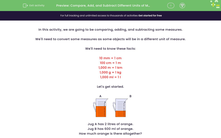In this activity, we are going to be comparing, adding, and subtracting some measures.
We'll need to convert some measures as some objects will be in a different unit of measure.
We'll need to know these facts:
10 mm = 1 cm
100 cm = 1 m
1,000 m = 1 km
1,000 g = 1 kg
1,000 ml = 1 l
Let's get started.
A B


Jug A has 2 litres of orange.
Jug B has 600 ml of orange.
How much orange is there altogether?
Answer:
In this question, we need to convert the units of measure so that they are the same.
We know that 2 l = 2,000 ml
Jug A = 2,000 ml
Jug B = 600 ml
2,000 + 600 = 2,600 ml
There is 2,600 ml of orange juice.
We can convert this back to litres by dividing by 1,000
2,600 ÷ 1,000 = 2.6 litres.
Let's have a look at another question.

The chair is 98 cm tall.
How tall would two chairs be?
Answer:
In this question, we simply need to add 98 cm and 98 cm = 196 cm
Two chairs would measure 196 cm
Let's have a look at one more question.


The shopping bag weighs 1,100 g
The blue rucksack weighs 1.2 kg
Which bag is heavier?
Answer:
We need to convert both measures to the same unit of measure.
There are 1,000 g in 1 kg
1,100 g = 1.1 kg (divide by 1,000)
Shopping bag = 1.1 kg
Rucksack = 1.2 kg
The rucksack is the heaviest.

Now it's your turn to have a go at some questions!







